|
Cossypha caffra (Cape
robin-chat, Cape
robin)
Gewone janfrederik [Afrikaans]; Ugaga [Xhosa]; uGaga, umBhekle
[Zulu]; Sethoenamoru, Sethoena-moru, Setholo-moru [South Sotho]; Kaapse
lawaaimaker [Dutch]; Cossyphe du Cap [French]; Kaprötel [German]; Cossifa
do Cabo [Portuguese]
Life
> Eukaryotes >
Opisthokonta
> Metazoa (animals) >
Bilateria >
Deuterostomia > Chordata >
Craniata > Vertebrata (vertebrates) > Gnathostomata (jawed
vertebrates) > Teleostomi (teleost fish) > Osteichthyes (bony fish) > Class:
Sarcopterygii (lobe-finned
fish) > Stegocephalia (terrestrial
vertebrates) > Tetrapoda
(four-legged vertebrates) > Reptiliomorpha > Amniota >
Reptilia (reptiles) >
Romeriida > Diapsida > Archosauromorpha > Archosauria >
Dinosauria
(dinosaurs) > Saurischia > Theropoda (bipedal predatory dinosaurs) >
Coelurosauria > Maniraptora > Aves
(birds) > Order: Passeriformes
> Family: Muscicapidae > Genus: Cossypha
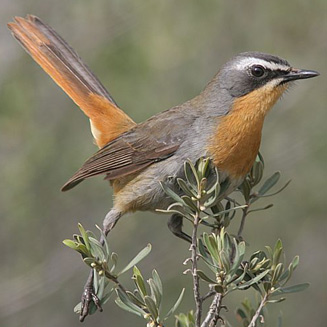 |
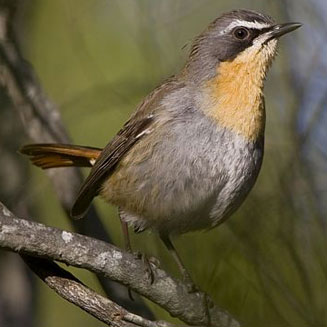 |
| Cape robin-chat, Karoo Botanical
Gardens, South Africa. [photo Trevor Hardaker ©] |
Cape robin-chat, Kirstenbosch Botanical
Gardens, South Africa. [photo Trevor Hardaker ©] |
Distribution and habitat
Occurs in patches from southern Sudan to Kenya, eastern DRC
and Tanzania, with the largest population in southern Africa. Here it is common
across South Africa, Swaziland, Lesotho, southern Mozambique and southern
Namibia, with an isolated population in Zimbabwe's eastern Highlands. It
occupies a variety of habitat types, generally preferring areas with quite dense
undergrowth and scattered trees, bushes, rocks or other structures to use for
perching, along with surface water for drinking and bathing. It is a common bird
in gardens across much of its distribution, including in city centres such as in
Cape Town.
|
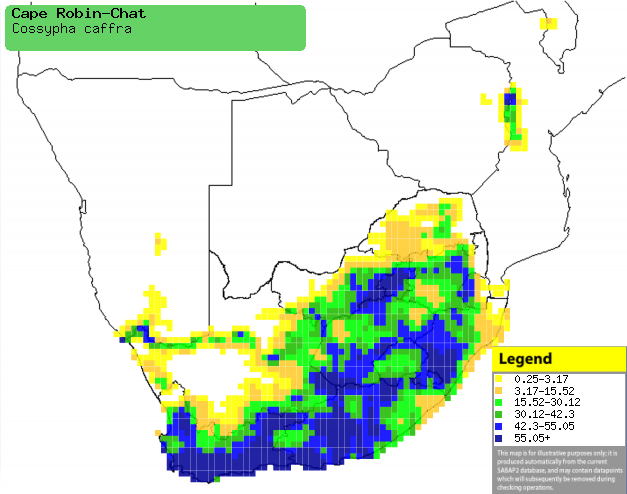 |
|
Distribution of Cape robin-chat in southern Africa,
based on statistical smoothing of the records from first SA Bird Atlas
Project (©
Animal Demography unit, University of
Cape Town; smoothing by Birgit Erni and Francesca Little). Colours range
from dark blue (most common) through to yellow (least common).
See here for the latest distribution
from the SABAP2. |
Brood parasites
It has been recorded as host of the
Red-chested cuckoo.
Food
It mainly eats insects and other
invertebrates, supplemented with fruit and seeds plucked from bushes, trees or
the ground. It does a lot of its foraging in leaf litter, flicking through plant
debris in search of food and occasionally aerially hawking an insect; it may
also glean invertebrates from leaves, branches and rocks. The following food items have been recorded
in its diet:
- Animals
- Invertebrates
- Insects
-
spiders
- earthworms
-
millipedes
- Theba pisana (a species of alien snail)
- crustaceans
- Vertebrates
- Berries, drupes and seeds
- indigenous plants
- Apodytes dimidiata (White-pear)
- Asparagus falcatus (asparagus)
- Cassipourea gummiflua (Large-leaved onionwood)
- Celtis africana (White-stinkwood)
- Ficus sur (Broom-cluster fig)
- Halleria lucida (Tree-fuchsia)
- Ilex mitis (African holly)
- Kiggelaria africana (Wild-peach)
- Lycium (honey-thorns)
- Gymnosporia harveyana (Black forest spikethorn)
- Phoenix reclinata (Wild date palm)
- Pterocelastrus tricuspidatus (Candlewood)
- Rhamnus prinoides (Shiny-leaf)
- Rhus nebulosa (Coastal currant)
- Rhus pyroides (Common currant)
- Scutia myrtina (Cat-thorn)
- Coddia rudis (Small bone-apple)
- Xymalos monospora (Lemonwood)
- alien plants
- Acacia cyclops (Rooikrans)
- Atriplex semibaccata (Creeping saltbrush)
- Hedychium flavescens (Ginger lily)
- Lantana camara (Cherry-pie)
- Morus alba (Mulberry)
- Myoporum laetum (New Zealand manatoka)
- Physalis peruviana (Cape gooseberry)
- Psidium guajava (Guava)
- Rubus (blackberry)
- Solanum mauritanum (Bugweed)
- Miscellaneous
- cheese
- butter
- leftovers from dogs' bowls
Breeding
- Monogamous, highly territorial solitary nester, as the male aggressively
defends his territory against other males as well as other species, such as
white-eyes,
sunbirds and
doves.
- The nest is usually built solely by the female in about 1-14 days,
gathering a clump of material together before shuffling its body into it to
form a cup. It is usually made out of bark fragments, twigs, dry grass, fern
fronds, rootlets, dead leaves, moss and seed pods and lined with finer
fibres, such as hair, rootlets and plant inflorescences. It is most commonly
placed in a hollow in an earthen bank, cavity in a tree trunk, densely
foliaged shrub, dry flood debris along a stream bank, or in pots or boxes
overgrown with vegetation. It has even been recorded to placed the nest in a
dried flower arrangement in the lounge of the Grahamstown Golf Club!
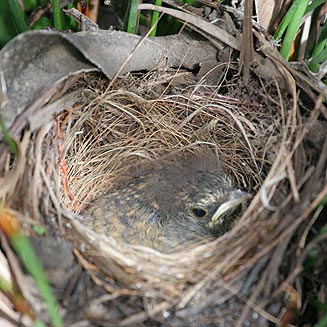 |
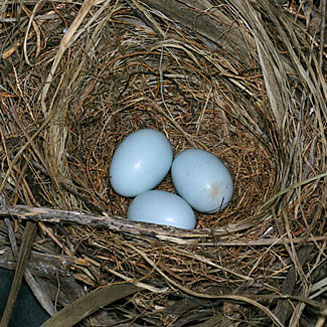 |
|
Cape robin-chat chick in nest, West Coast Fossil Park, Western Cape, South Africa. [photo H. Robertson,
Iziko ©] |
Cape robin-chat nest with eggs, Machadodorp, South
Africa. [photo Warwick Tarboton ©] |
- Egg-laying season is from about June-January, peaking around
October-November.
- It lays 2-3 eggs, which are incubated solely by the female for about
14-19 days.
- The female broods the chicks throughout the night and intermittently
through the day, for the first 5-11 days of their lives. They are fed by
both parents, eventually leaving the nest at about 14-18 days old, remaining
dependent on their parents for about 5-7 weeks more. During this period the
adults are particularly viglant about protecting their young, sometimes
attacking snake such as boomslangs (Dispholidus typus) and Cape
cobras (Naja nivea).
Threats
Not threatened, in fact it has adapted to well to the
introduction of man-made habitats.
References
-
Hockey PAR, Dean WRJ and Ryan PG 2005. Roberts
- Birds of southern Africa, VIIth ed. The Trustees of the John Voelcker
Bird Book Fund, Cape Town.
|
